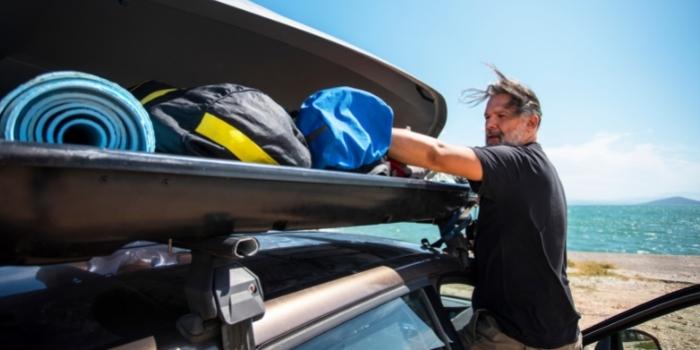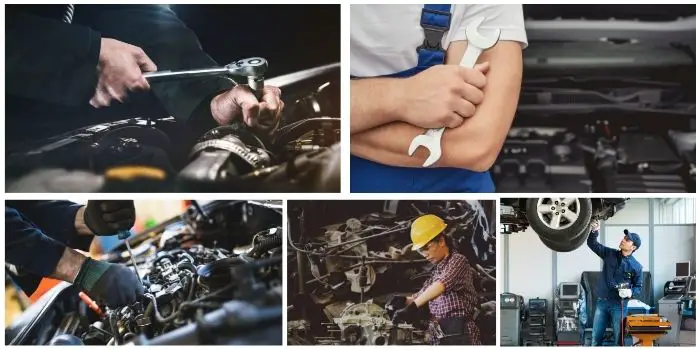If you don’t own a large-sized car capable of carrying your bicycle or surfboards – don’t worry.
You can always find ways to accommodate them in your car without disturbing your passengers.
No need for the passengers to sit in the cramped space due to the space occupied by surfboards.
Because the above issue can easily be addressed by installing roof racks or carriers.
A roof rack (also referred to as crossbar, and roof bar) is a must-have for car owners who need to carry extra stuff when traveling.
Especially for campers installing a roof rack is beneficial by which they can easily carry goods that will generally not fit inside their car.
Table of Contents
Different Types of Car Roof Racks
There are many different types of car roof racks to choose from, depending on your needs.
Some of the most popular options include:
1- Cargo carriers
The most popular type is the cargo carrier, which is great for carrying extra luggage or gear on long trips.
Cargo carriers are available in a variety of sizes and styles, so you can find one that’s just right for your vehicle.
These carriers attach to the roof of your car and provide extra storage space for luggage, gear, or other items.
Some cargo carriers come with features like a cover to protect your belongings from the elements, and some even have built-in lighting for greater visibility at night.
2- Naked roof racks
These are the most basic and economical types of roof racks.
They typically consist of two or four crossbars that attach to your vehicle’s rain gutters or door frames, and they don’t include any side rails.
If you’re transporting a lot of gear, you might want to consider a naked roof rack with an extension, which will give you more space to work with.
3- Side rails racks
These have long, horizontal side rails that run the length of your vehicle’s roof.
These racks provide more stability than naked roof racks and are great for carrying bikes, skis, or other gear that needs to be securely attached.
4- Basket racks
These are similar to cargo carriers, but they’re usually smaller in size and don’t have a lid.
Basket racks are a good option if you need to transport smaller items or if you want easy access to your gear.
5- Hitch racks
These are designed to attach to the hitch on the back of your vehicle.
These racks are great for carrying bikes, but they can also be used for cargo carriers and other types of gear.
6- Fixed point racks
These are permanently attached to specific points on your vehicle’s roof.
These racks are usually more expensive than other types of racks, but they’re also the most secure, making them a good option for carrying bikes or other gear that needs to be securely attached.
7- Roof box
This is a storage box that mounts to the roof of your vehicle.
Roof boxes are great for carrying extra gear on long trips, and they’re usually large enough to accommodate skis, snowboards, and other bulky items.
8- Ski racks
If you’re an avid skier or snowboarder, you might want to consider a ski rack, which attaches to the roof of your car and holds skis or snowboards.
Ski racks typically come in two-ski and four-ski capacity models.
9- Canopy mounts, t-slot channels, and other specialty mounts
Most car roof racks will bolt to existing factory mounting points or use special clamps that attach to the door frame or rain gutters.
Some vehicles, however, require specialized mounts or t-slot channels in order to install a roof rack.
Canopy mounts are typically used on vehicles with soft-top roofs, and t-slot channels are often used on vehicles with naked roofs.
What are Roof Racks Used for in Cars?
The crossbar on a car can prove to be useful for various purposes.
Let us look at how roof racks can be put to better use.
1- Awnings
Have you ever thought of creating a shelter by using awning?
Certain roof rack types specifically designed for this purpose can come in handy in installing awnings over the roof or on either side or the backside of your car.
This enables you to use the extra area as shelter which gives you shade during sunny times. The extended area under the awning can be used for BBQ or food preparation purposes.
2- Securing load
Whenever you plan for a weekend trip or lengthy trip, there must be a lot of things for you to pack and you might find yourself want of space.
You can opt for an alloy tray or mesh basket or roof-top box that is sturdy, all weatherproof to accommodate extra items that don’t fit easily inside the car.
Sometimes you would be placing expensive items like kayaks or surfboards on the roof rack. These items can be stolen easily within a glimpse.
But to make it secure and safe from being stolen, it is wise to invest in a quality locking strap.
These reinforced lock straps made of stainless steel are hard and cannot be cut easily with a knife. It can lock in your surfboard or kayak perfectly.
3- Carrying a bicycle or surfboard
Carrying bicycles in your car can be a challenging task unless you have a specially designed bike carrier attached to the rear of your car.
They are available with or without a tow bar for all types of cars.
Surfboards, snowboards, and paddleboards can be carried on the roof racks, making more free space available for the passengers and luggage inside the car.
While trying to pack heavy kayaks or canoes you will be needing the assistance of one or two people for easier loading and locking it perfectly.

How to Use a Roof Rack Safely?
The major components of the roof racks are towers, mounts, and side rails.
The towers are attached to the rails, while the mounts hold the roof rack firmly to the car roof.
To give better stability without swaying while driving, tie down the items you place on the roof rack from all four corners.
Wrap the items you place on the roof rack multiple times to avoid any dislodging from all four corners to ensure they are secured.
When you tie it, make sure to provide a firm tight grip to the straps in a single knot itself, instead of tying with multiple clumsy knots.
It’s common for people to use roof racks and you need not worry about their safety and other features.
No one will be using these if they find that their items are getting lost because they kept them on the roof rack.
Moreover, even while you travel, you can see many cars plying on highways with roof racks with items fully loaded and driving at a good speed without any worries.
That is the trust people have in these roof racks while traveling without any worries, provided they follow the safety tips mentioned below:
1- Correct Fit
First thing is to select the right roof rack that fits correctly.
Other points you going to follow will not work if the exact fitting roof rack is not chosen.
Just imagine, if the fitting is not perfect, what will happen when you are zooming in at 100 miles per hour with a load above 100lbs?
The items along with the roof rack can fall and break down due to the air pressure caused by the heavy blowing winds.
When fitted correctly, these speeds or weights are not an issue for the roof rack to handle.
2- Correct Installation
After choosing the suitable roof rack for your car, now is the time for installation.
You don’t need big tools to install and can be done easily with relatively small tools.
Sometimes you don’t need any tools for installation—no need to worry in the future once the installation is done perfectly.
3- Height Restrictions
Installing roof racks will definitely increase the height of your vehicle and it increases more when you load items on it.
If you own tall cars like SUVs, then you should be careful while driving through roads with low height caution.
When you load it up with kayaks or mountain bikes, make sure you slow down and pass through that area with caution.
4- Center of Gravity
When you have decided to load items on the carrier, make sure to load the heavy items in the center surrounded by light materials around the sides and corners.
If you place the heavy items around the edges or sides, there are chances that they might lose control over the straps and fall when you maneuver through the curves or go at high speed.
5- Total Weight
Take into mind the total weight that your roof rack can handle smoothly.
If the items are placed in such a way that the weight is distributed evenly throughout then they can handle up to 150 lbs normally.
If the item’s size is uneven and weight gets concentrated in one or two places in a roof rack, then it is better not to load up further as extra caution is needed when weights get concentrated in one place.
Some common problems encountered by people while using roof racks are – the formation of dust under the roof rack grills that can erode the coating.
While strapping the items tightly along with the roof rack can cause the paint to strip away over a period of time.
Sometimes, roof racks get dislodged when driving at a higher speed. Following the above tips are easy and gives you stress-free riding.

What to Look for When Choosing a Roof Rack?
You may own a car without a carrier or roof rack.
In such cases, you can browse through the plenty of roof racks available in the market to choose from.
Before buying it – lookout for the features mentioned below:
1- Connectors –
As per the design of your car, you have to use connectors that suits you well.
Below are the different methods you can try to fix the roof rack for your car.
2- Construction Material –
When it comes to the material of roof racks – it is either steel or aluminum.
Steel is not costly but weighs more. In the case of aluminum, even if it is a little costly – it is worth the money due to its lightweight nature and design.
3- Keyed Lock –
Roof racks that attach with a clamp should be secured with keyed lock to prevent thieves from stealing them.
Roof racks that are secure via fixing points or inside the door jamb don’t need to be locked.
4- Weight Capacity –
When choosing a car roof rack, it’s important to consider the weight and size of the items you’ll be carrying as well.
On average, a weight of 150 to 160 lbs can be carried easily on roof racks for many trips.
If you need more, you have to take into consideration the build of your car as well as the roof rack.
5- Aerodynamic/Low Profile Design –
It’s a plain piece of knowledge, that when you load heavy items like kayaks on the roof rack or bicycles on the bike carrier on the rear of your car, the performance and fuel efficiency of your car will come down.
Down the line, continuous usage of roof racks with a full load or without any load will lead to poor mileage.
Caution must be exercised in installing aerodynamic roof racks to nullify or reduce the negative effects.
Final Thoughts
When buying roof racks for your vehicle there are certain things you will need to check for.
Safety should be of paramount importance when it comes to choosing a crossbar and carrying large objects in your car.
No matter what type of rack you choose, make sure it’s compatible with your vehicle.
Hopefully, by following some good tips above, you can make your travel with big objects a breezy one.

Based in Orem (Utah) John Paterson graduated from Utah Valley University and has begun writing in 2009. He has a large wealth of experience in writing articles related to cars, automotive repair, wheels, cleaning/maintenance, and much more. He has also written instructional articles in a similar niche for a few online publications as well. Currently, he works as a mechanic in his personal garage shop where he loves serving his countrymen from his heart.





